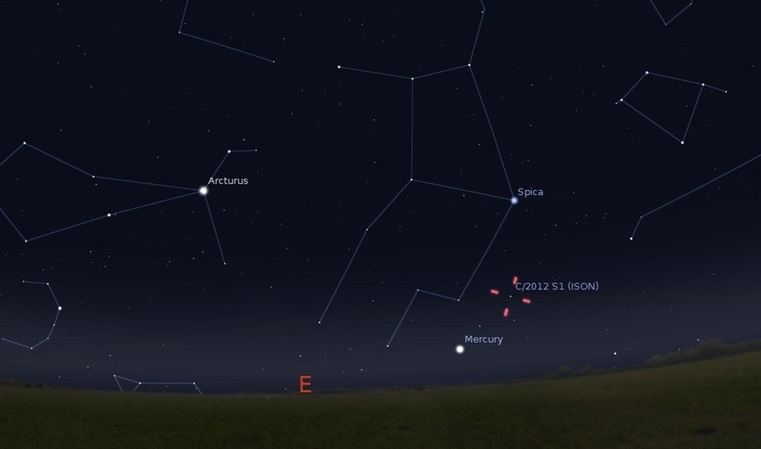Camera: Nikon D7000. Lens: Tamron 300mm.
f/5.6. S: 30sec x 4.
Sky transparency at location was bad due to fog and strong Moon light.
|
We had a Comet LOVEJOY shooting session in the night between 23rd and 24th Nov. This is one of the frames captured. Location: Bidhannagar. North Dinajpore: West Bengal. India.
Camera: Nikon D7000. Lens: Tamron 300mm. f/5.6. S: 30sec x 4. Sky transparency at location was bad due to fog and strong Moon light.
0 Comments
ISON NEWS FLASH: 07:00 UT. 26th Nov. As the latest Jet Propulsion Laboratory info says- ISON is not leaving us forever. It will come back again. After 581480.34 years. Now its orbit is being considered as a long long ellipse with its eccentricity as .9999982136165803.But yes, scientists are still not sure on this. calculations are going on.
 It is almost time to say Good Bye to Comet ISON in its first phase of visibility. Every day the comet is coming closer to Sun and getting deeper and deeper into the glare of Sun making it a difficult object to see. Moreover, though at weaning phase, Moon is still too bright in early morning. However, here is the position of that for 21st Morning just about 1.5 hour - 1hour before sun rise . If anyone gets interested to take a desperate attempt to find it. This simulated image is for lat 26, Long 88. But the angular distance of the comet from bright star Spica will remain almost same for almost all coordinates. All the best and wishing you a clear sky. Happy to present you the pictorial record of SWAN's first glimpse of Comet ISON. Taken on 17th Nov 04:59AM IST. Had a plan to shoot it from Jalpaiguri through guided mount and Telescope. But, sudden cloud formation in east horizon from 3:00AM forced us to take hasty decision to leave all equipment and move only with camera and lens. A risky journey of 30km, a chase for clear sky, it was. But finally came out to be rewarding. May not be of very high class, but we loved this image, our first view of Comet ISON.
This is a non stacked single frame image of comet ISON.  Position of ISON will be around 15-25 degree above Eastern Horizon between 4.30 am to 5.15 am this (16th Nov IST) morning (All over India). Please observe it from your location and then report us at http://www.skywatchersindia.com/brightness--visibility.html with details. You may observe ISON only with naked eye or any optical gadget. Submit the details of your gadget too, if any.
Finally it has come into the domain of naked eye. Comet ISON. The much awaited Comet is now visible with naked eye after a massive outburst of its materials due to Solar heat and gravitational pull. In good side, the outburst has increased the comets visibility, in bad side it has increased the chance of the comet’s disintegration. Thirteen days more for the comet to reach the closest distance to Sun. Not known whether it can survive that long or not. Thus, have a look now, get a glimpse of the great comet, experience the view of a celestial guest in our sky from the outermost layer of our solar System. Like many from different corners of the globe you too can contribute your observation report to our site.
Visit : http://www.skywatchersindia.com/brightness--visibility.html If you are observed ISON or Lovejoy then you may like to submit your ISON or Lovejoy observation report here. That will be reflected in our central database with full credit given to you.
Please provide original observational data. to submit the form follow the link http://www.skywatchersindia.com/brightness--visibility.html Many of us are yet to have their first glance of ISON. People have started considering ISON’s performance as poor. Many resource sites have also given update in that line. But not everything is that bad. See what the latest update by Comet ISON Observing Campaign of NASA says. “Comet ISON is doing just fine! .’ It also says “By far the best opportunity for naked-eye viewing of the comet will be in early-to-mid December as it climbs back into the night skies. Of course, this is all dependent on it reaching and surviving perihelion... “ But more exciting thing is- we now have X-ray detection of comet ISON from the NASA Chandra X-ray Observatory.
You may see the Global observation report (Red dots) plotted on the prediction (Black line). Many of the latest observations are almost on predicted line. Though many others found the brightness as much lower than the predicted level. For image click here http://www.isoncampaign.org/files/images/ison_lc_nov11.jpg |